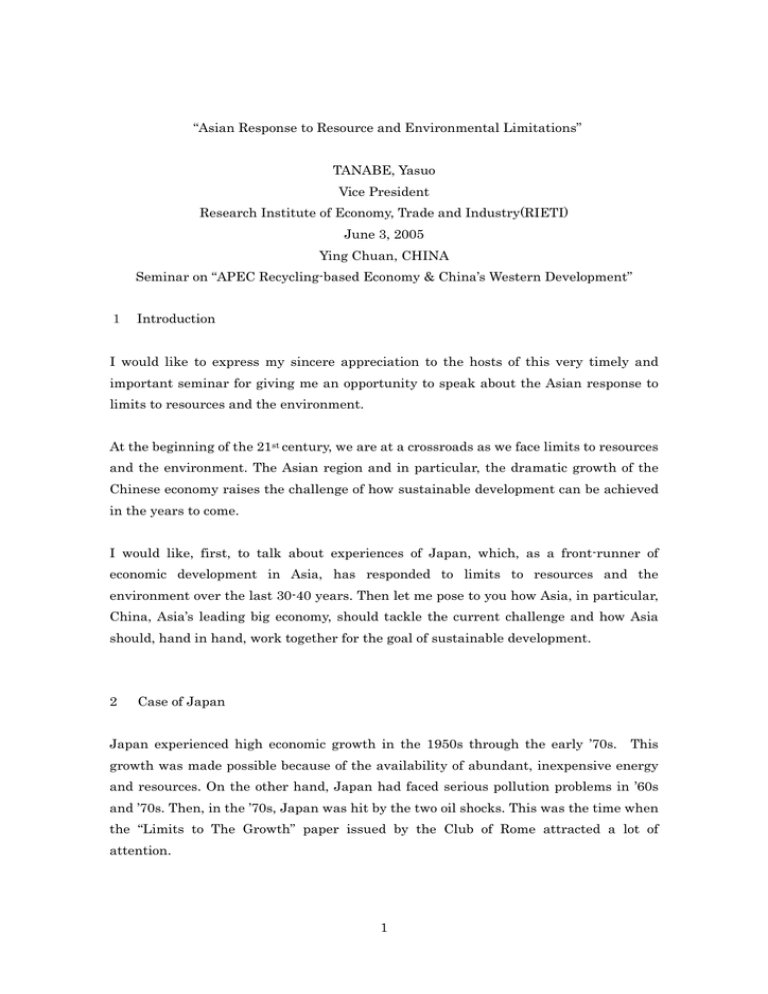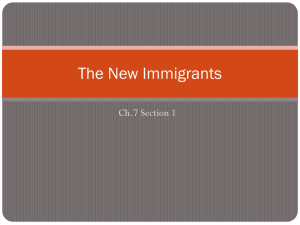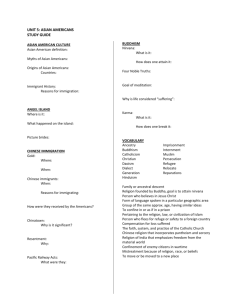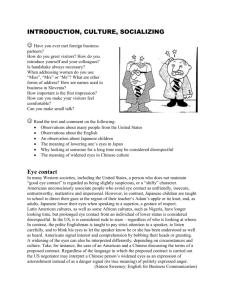“Asian Response to Resource and Environmental Limitations” TANABE, Yasuo Vice President
advertisement

“Asian Response to Resource and Environmental Limitations” TANABE, Yasuo Vice President Research Institute of Economy, Trade and Industry(RIETI) June 3, 2005 Ying Chuan, CHINA Seminar on “APEC Recycling-based Economy & China’s Western Development” 1 Introduction I would like to express my sincere appreciation to the hosts of this very timely and important seminar for giving me an opportunity to speak about the Asian response to limits to resources and the environment. At the beginning of the 21st century, we are at a crossroads as we face limits to resources and the environment. The Asian region and in particular, the dramatic growth of the Chinese economy raises the challenge of how sustainable development can be achieved in the years to come. I would like, first, to talk about experiences of Japan, which, as a front-runner of economic development in Asia, has responded to limits to resources and the environment over the last 30-40 years. Then let me pose to you how Asia, in particular, China, Asia’s leading big economy, should tackle the current challenge and how Asia should, hand in hand, work together for the goal of sustainable development. 2 Case of Japan Japan experienced high economic growth in the 1950s through the early ’70s. This growth was made possible because of the availability of abundant, inexpensive energy and resources. On the other hand, Japan had faced serious pollution problems in ’60s and ’70s. Then, in the ’70s, Japan was hit by the two oil shocks. This was the time when the “Limits to The Growth” paper issued by the Club of Rome attracted a lot of attention. 1 Accordingly, Japan had to transform its economy from its highly environment- and energy-intensive economic growth path. The Japanese economic model has thus shifted and evolved from one of limitless resources and environmental capacity in an era that must face such limits. In concrete terms, this meant Japan had overcome such problems as air and water pollution through the efforts of industry due considerably to regulations and guidance by the government. Also in response to the rise in oil prices, Japan has achieved a highly energy-efficient economy as a result of efforts by industry and the general public. The government also promoted this shift by incentives such as soft loan and made regulation in a proper manner. Japan’s industrial and economic structure has thus changed. Although economic growth has slowed since the bursting of the “bubble economy” in the ’90s, Japan has been making efforts to create an economy and society capable to respond to limits to resources and the environment. The examples include actions and programs taken in response to the agreement and ratification of the Kyoto Protocol, and a series of recycling laws including the “Basic Law on Building a Recycling-oriented Society.” Japan’s experience has not been a straight line of progress; in fact we have had many difficulties. It can be said, however, that overall Japan’s performance in sustainable development has been good. What lies behind this success is the fact that we have properly received the signals of limits to resources and the environment and in response to these signals all parties ― government, industry and the public ― have, with shared responsibility, taken appropriate actions in their own roles to reform the social and economic system. 3 Case of China and Asia Asian countries including China have developed according to the “Flying Geese” model since the 1970s. The economies of the NIEs, ASEAN and China have grown, one after another, following Japan’s economic development. Trade and investment relations between these economies and Japan have played a significant role in this process. Thus, Asian economic integration has progressed to the point where the intra-East Asia trade ratio has reached about 50%. It goes without saying that the leading engine of this 2 economic integration is China which is often called the “world’s factory.” This economic integration should and will continue to grow for the welfare of Asian people. In recent years, however, this Asian economic integration model has been faced with limits to resources and the environment, just as Japan did 30 years ago. What triggered this is resource-intensive Chinese economic growth. The recent rise in oil prices is a typical example. The average WTI price in 2004 rose to 41 US$ per barrel from 27 US$ in 2003. It stands around 50 US$ in this year. The growth in China’s demand for oil is not the only factor behind this rise, of course, but there is a consensus view among international experts that it is the major factor. The situation can be explained by the supply and demand curve familiar to us in economics. That is to say, the marginal growth in demand in the midst of the very limited spare supply capacity and low price elasticity leads to price hikes. The same explanation holds for other commodity markets such as coal and iron ore. The impact of Chinese demand in international markets is tremendous. The high prices of these resources are affecting not only economies where demand is growing, like China, but also in mature economies like Japan. All of us in Asia, and indeed around the world are facing limits to resources. The environmental challenge is also serious. Environmental problems are becoming serious in Asia, including China, as it develops economically. It is said more than 200 million people, or 64% of the urban population, are suffering from air pollution in China. China’s environmental problems are also affecting neighboring countries. For example, acid rain originating from China, is pouring onto the Korean peninsula and Japan. Yellow sand stemming from desertification on the continent is also drifting over the Korean peninsula, Japan and even the Pacific. Thus, environmental problems affect not just one country but the region as a whole. We in Asia are facing a common environmental challenge. Furthermore, the climate change issue is global in scale. According to the IPCC forecast, if nothing is done, the average global temperature will rise 1.4 -5.8 degrees centigrade by 2100. The largest emitter of greenhouse gases is currently the United States but China, which is at present the third-largest emitter, is expected to exceed the U.S. in future. Although the Kyoto Protocol took effect this year, the countries bound by the treaty account for only one-fourth of the world’s greenhouse gas emissions. An effective 3 global framework, including countries like China, should be pursued. 4 Asian Response to the Challenge I am not saying that developing economies like China should not grow. It is legitimate that people in China and in Asia want to be richer. In fact, the world economy also benefits from China’s and Asia’s economic growth. What is important is that this economic growth be made compatible with limits to resources and the environment. Let me explain the theory of the “environmental Kuznets’ curve,” which has been posited by the World Bank. It tells us that environmental impact, say, air pollution, will grow in line with economic (income) growth in the initial phase of development, but at a later stage in development it will decline. This can be seen in the upside-down “U” shape in the graph where vertical axis is environmental impact and the horizontal axis is the level of economic development. It is said a level of US$3000-8000US$ per-capita income is the peak of environmental impact depending on types. Asia should challenge this theory. That is to say, the level of peak environmental impact (the vertical axis) should be lowered and the developmental stage (the horizontal axis) of peak environmental impact should be shifted forward (to the left in the graph). This should be possible because of late-comers’ advantage and the learning effect. This is absolutely essential in the field of resources and the environment where changes are often irreversible. In the past, developed economies consumed a large amount of copper in order to build telephone lines, but nowadays the technology of mobile phones has reduced consumption of this resource. With technological progress, this type of “leapfrogging” is possible. I believe that Asia is particularly suited to this kind of action because of its high literacy, Confucian ethics, pragmatism and strong community orientation. How should Asia respond to limits to resources and the environment? In theory, the environmental impact (I) is determined by the three variables of population (P), affluence (A), and technology (T). It is possible to lower I by controlling the three variables P, A, and T. China, the most populous country in Asia, has made efforts to contain population growth. As for affluence A, it is not realistic to deny the desire of people in the developing countries of Asia for enhanced economic welfare, but it is worth promoting a greater “spiritual” or functional affluence rather than mere physical affluence. The most important variable is technology T. This refers not only micro-level 4 physical engineering technology but also to macro-level social engineering, or institution building, in a broader sense. With this technological progress it is possible to check environmental impact while enjoying economic growth. There are two sides to economic activities. The front-end activities, that is, the stream of production, distribution and consumption, are called the “artery economy.” The back-end activities, that is, the end-of-life, or post consumption stream is called the “vein economy.” First, the artery economy should become more eco-efficient, in other words, resource productivity should rise. A target called “Factor X” has been proposed by experts. For instance, “factor 4” means that the resource productivity should be four times greater than now, which would allow wealth to double while reducing resource depletion or environmental impact by half. Let me take up, at the macro-level, the example of the indicator called energy intensity, which is energy consumption per unit of GDP. The energy intensity of the U.S. is twice as that of Japan. In other words, the resource productivity of the U.S. is one–half that of Japan. The energy intensity of China is 10 times that of Japan. In other words, China’s resource productivity is one-tenth that of Japan. From this indicator, we can say that both the U.S. and China can and should improve their eco-efficiency. If we look at the indicator of energy consumption per capita, a different view emerges. In this case, per-capita energy consumption in the U.S. is twice as high as Japan, while that of China is one-fifth as high as Japan. In other words, U.S. energy intensity per capita is 10 times higher than China. The U.S. should improve its eco-efficiency, while Chinese people may be allowed to use more energy as its economy develops. But it is horrible to imagine that China may consume 10 times as much energy in the future as it does today, reaching the same per-capita energy intensity as the U.S. In this scenario, the sustainability of world resources and the environment would be seriously jeopardized. Even if China achieves a Japanese level of per-capita intensity, Chinese energy consumption would increase fivefold, still a horrible prospect. We can also look at the micro level industrial sector, such as energy consumption per unit of industrial output. For steel, Chinese consumption is 50% than Japanese; for paper and pulp, Chinese consumption is 124% higher; for cement, 44% higher. As for the thermal efficiency of power generation plants, the average Chinese plant is 33% 5 efficient, while the Japanese average is 45%. In sum, there is a huge potential in China for improvement of energy efficiency. It is also important that in the vein economy products at the end-of-life should be properly recycled. Recycling is indispensable to slow the depletion of non-renewable resources and to avoid unproductive use of land as final disposal sites. In Japan, streams of recycling have developed one by one, such as for packaging, home appliances, PCs and automobiles. Needless to say, traditional recycling streams such as paper, metal cans, and glass bottles, have been maintained and upgraded. should be developed throughout Asia. Similar schemes Further, if the recycling chain at cross-border level is implemented properly in Asia, with no leakage in the environment, it would help overcome limits to resources and the environment. Both the artery and vein streams should be developed integrally. In the developed countries of the West, the two streams of supply chain have historically tended to be separate. In Japan, on the other hand, since the Edo-era some 300 years ago, there has been a recycling orientation in the supply chain. The spirit of mottainai, which means too precious to waste, has supported the tradition of recycling in Japanese society. This spirit should be disseminated throughout in Asia to build regionwide recycling society. Japanese manufacturing also has been supported by workers’ high sense of ethics, which is exemplified in the kaizen process, or TQC activities. This manufacturing system has also contributed to eco-efficient production in Japan. It is expected that this eco-efficient production system will spread throughout Asia as many Japanese companies invest in the region. The economic integration in Asia should be developed in this way to promote sustainable development. China represents a big test for sustainable development in Asia, since its vastness in terms of land and population is quite different from Japan. India, whose population is expected to exceed that of China, presents a similar challenge. As China develops it should avoid the path taken by the U.S. in terms of its massive environmental impact. Japan offers a better model in the sustainable development. However, China should pursue a bolder “Factor X” model of resource productivity, taking advantage of its latecomer position in attempt to leapfrog response. It is encouraging that the Chinese government, perhaps because it is well aware of the facts and theory I have described, has recently embarked on greater efforts in the area 6 of resources and environment. I understand that Chinese authorities are eager to learn from the experiences of Japan and other developed countries. Of course, policies and regulations are only as good as their actual enforcement under certain peculiar conditions in each country and region. However, I can say that strong enforcement of policy requires shared responsibility and cooperation of all stakeholders of society, that is government, industry, academia and the public. To put simply, it requires institution building and development of human resources. 5 Conclusion A competitive production network has been established around the world’s factory, China, in the system of economic integration in Asia. This Asia-wide production network, or artery economy, should become more sophisticated in terms of resource productivity and eco-efficiency. We also should remember to develop a more efficient vein economy comparable in competitiveness to the artery economy. Japan is willing to assist Asian economic integration, helping it to become a true world leader in the artery and vein economy, as Japan has contributed to the development of economic integration through trade and investment with the spillover of its technology and skills. Needless to say, own commitment and efforts of each country in Asia, in particular China, is the starting point. What is most important is human resource development in reform of the social and economic system, or institution-building. Human resource development is necessary in all sectors, including government in designing the social and economic system, in industry in operating the system, in academia in analyzing the system and among the public as beneficiaries of the system. I hope this seminar will serve this purpose well. Thank you very much. 7




